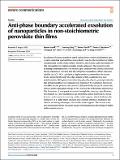Files in this item
Anti-phase boundary accelerated exsolution of nanoparticles in non-stoichiometric perovskite thin films
Item metadata
| dc.contributor.author | Han, Hyeon | |
| dc.contributor.author | Xing, Yaolong | |
| dc.contributor.author | Park, Bumsu | |
| dc.contributor.author | Bazhanov, Dmitry I. | |
| dc.contributor.author | Jin, Yeongrok | |
| dc.contributor.author | Irvine, John T. S. | |
| dc.contributor.author | Lee, Jaekwang | |
| dc.contributor.author | Oh, Sang Ho | |
| dc.date.accessioned | 2022-11-07T13:30:17Z | |
| dc.date.available | 2022-11-07T13:30:17Z | |
| dc.date.issued | 2022-11-05 | |
| dc.identifier | 282042247 | |
| dc.identifier | 43dfe239-4961-4429-8f88-e2caa954d34c | |
| dc.identifier | 85141359028 | |
| dc.identifier | 000879737500008 | |
| dc.identifier.citation | Han , H , Xing , Y , Park , B , Bazhanov , D I , Jin , Y , Irvine , J T S , Lee , J & Oh , S H 2022 , ' Anti-phase boundary accelerated exsolution of nanoparticles in non-stoichiometric perovskite thin films ' , Nature Communications , vol. 13 , 6682 . https://doi.org/10.1038/s41467-022-34289-3 | en |
| dc.identifier.issn | 2041-1723 | |
| dc.identifier.other | Jisc: 706039 | |
| dc.identifier.other | publisher-id: s41467-022-34289-3 | |
| dc.identifier.other | manuscript: 34289 | |
| dc.identifier.other | ORCID: /0000-0002-8394-3359/work/122719753 | |
| dc.identifier.uri | https://hdl.handle.net/10023/26318 | |
| dc.description | Funding: This work was supported by National Research Foundation of Korea (NRF) grant funded by the Korea government (MSIT) (No. NRF-2020R1A2C2101735), Creative Materials Discovery Program (NRF-2019M3D1A1078299), the Samsung Research Funding & Incubation Center of Samsung Electronics under Project Number SRFC-MA1702-01, and the KENTECH Research Grant (KRG2022-01-019). D.I.B. acknowledges the financial support from Russian Foundation for Basic Research under Grant No. 19-29-03051MK. The first-principle calculations were performed using the facilities of the Joint Supercomputer Center of the Russian Academy of Sciences (JSCC RAS). J.L. acknowledges the support of an NRF grant funded by the Korean government (NRF-2018R1A2B6004394). J.T.S.I. thanks the EPSRC for support on emergent nanomaterials through Grant EP/R023522/1. Y.X. and S.H.O. acknowledge the support from Advanced Facility Center for Quantum Technology. | en |
| dc.description.abstract | Exsolution of excess transition metal cations from a non-stoichiometric perovskite oxide has sparked interest as a facile route for the formation of stable nanoparticles on the oxide surface. However, the atomic-scale mechanism of this nanoparticle formation remains largely unknown. The present in situ scanning transmission electron microscopy combined with density functional theory calculation revealed that the anti-phase boundaries (APBs) characterized by the a/2 < 011> type lattice displacement accommodate the excess B-site cation (Ni) through the edge-sharing of BO6 octahedra in a non-stoichiometric ABO3 perovskite oxide (La0.2Sr0.7Ni0.1Ti0.9O3-δ) and provide the fast diffusion pathways for nanoparticle formation by exsolution. Moreover, the APBs further promote the outward diffusion of the excess Ni toward the surface as the segregation energy of Ni is lower at the APB/surface intersection. The formation of nanoparticles occurs through the two-step crystallization mechanism, i.e., the nucleation of an amorphous phase followed by crystallization, and via reactive wetting on the oxide support, which facilitates the formation of a stable triple junction and coherent interface, leading to the distinct socketing of nanoparticles to the oxide support. The atomic-scale mechanism unveiled in this study can provide insights into the design of highly stable nanostructures. | |
| dc.format.extent | 10 | |
| dc.format.extent | 6286592 | |
| dc.language.iso | eng | |
| dc.relation.ispartof | Nature Communications | en |
| dc.subject | QD Chemistry | en |
| dc.subject | DAS | en |
| dc.subject | MCC | en |
| dc.subject.lcc | QD | en |
| dc.title | Anti-phase boundary accelerated exsolution of nanoparticles in non-stoichiometric perovskite thin films | en |
| dc.type | Journal article | en |
| dc.contributor.sponsor | EPSRC | en |
| dc.contributor.institution | University of St Andrews. School of Chemistry | en |
| dc.contributor.institution | University of St Andrews. Centre for Energy Ethics | en |
| dc.contributor.institution | University of St Andrews. Centre for Designer Quantum Materials | en |
| dc.contributor.institution | University of St Andrews. EaSTCHEM | en |
| dc.identifier.doi | https://doi.org/10.1038/s41467-022-34289-3 | |
| dc.description.status | Peer reviewed | en |
| dc.identifier.grantnumber | EP/R023522/1 | en |
This item appears in the following Collection(s)
Items in the St Andrews Research Repository are protected by copyright, with all rights reserved, unless otherwise indicated.

